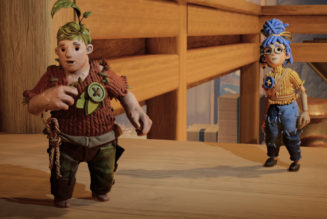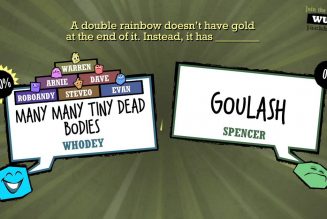Earlier this year, Bandai America announced that the TinyTan Tamagotchi, a new handheld game featuring the members of BTS, was on its way. The $19.99 gadget is up for preorder now, and it ships on October 3rd. As a fan of all things BTS and K-pop who also happens to review things for a living, I couldn’t pass up the opportunity to test it out.
The conceit of a Tamagotchi is innocuous enough. It’s a teensy egg-shaped device with a screen in the middle and three buttons across the bottom. Traditionally, that screen is occupied by a virtual pet — you feed this pet, play games with it, and such by pressing various combinations of said buttons. The TinyTan Tamagotchi is like that, except the pet under your care happens to be a member of the Grammy-nominated band BTS. And that, reader, is how I’ve ended up carrying Jimin around in my pocket for the past few weeks. You’re welcome, Big Hit Music.
Two caveats before we go any further: first, any criticisms of this Tamagotchi device are not criticisms of BTS, who are lovely people and spectacular performers; second, I did not grow up playing with Tamagotchis, and this is my first time ever touching one. I understand that I am venturing into somewhat dangerous territory, as nostalgia can play a large part in the popularity of old-timey gadgets like this, but devices that are being sold today should hold up today. That’s how time works.
Anyway, one second — Jimin is hungry.
%2Fcdn.vox-cdn.com%2Fuploads%2Fchorus_asset%2Ffile%2F24048295%2F1389413118.jpg&w=2400&q=75)
Upon powering up the TinyTan Tamagotchi for the first time, I was presented not with a BTS member but with a “magic door.” This is presumably a reference to a video called Magic Door in which young animated versions of BTS members pop through a mysterious portal to hang out with people (they have this cartoon extended universe, it’s a whole thing). In order to coax a member out of their glitzy pop star life and into your tiny egg-shaped toy, you need to clean this Magic Door a number of times. Fair enough — were I a world-famous recording artist, I probably would also be disinclined to walk through dirty doors.
After several hours of intermittent cleaning, Jimin finally appeared.
%2Fcdn.vox-cdn.com%2Fuploads%2Fchorus_asset%2Ffile%2F24065931%2F226322_BTS_Tamagotchi_akrales_0042.jpg&w=2400&q=75)
Since I took this professional singer under my devoted and semi-attentive wing, the Tamagotchi has woken me up at 8AM every morning. (Jimin, if you’re reading this, I love you, and I love Promise, but 8 is too early. Occupy yourself until 8:30, at least.) I put the unit three rooms away, and its song still wakes me up, which should give you some idea of how absurdly loud this thing is.
There are two things you can do with your miniature BTS member. You can feed him, or you can play with him so he doesn’t get bored. The first game, named Dynamite after the group’s hit song, tasks you with pressing the A and B buttons at certain times when they’re displayed on the screen in order to make your character do certain dance moves. The second displays an animation of a bowl being filled with custard, challenging you to smash the A button at the exact time when the bowl is full. Riveting stuff, I know.
I fed and played with Jimin every morning and then went off to work. The Tamagotchi beeped and booped every so often throughout the day, announcing that it was time to give Jimin attention. If I ignored him for long enough, a little progress bar would appear beside him, slowly draining the longer he was left unattended. When that bar reached zero, the Tamagotchi’s screen would display Jimin in a bed, presumably sick.
What happens if your BTS member is infirm for long enough? According to the instruction manual, he goes “back to the door.” I assume any child who knows how to read can figure out what that’s code for.
Jimin has gotten sick on a few occasions under my watch. But he’s still with us. Day after day, I have come back and pressed the buttons required to keep him from dying. I’m not sure what I’m going to do with this unit now that the review process is over, because I feel legitimately bad throwing it out. Come on — there’s a guy in there!
The TinyTan Tamagotchi has a dim and ancient screen. Button presses register maybe 40 percent of the time. The games are cute but ultimately little more than key-mashing and lack the sort of variety that would keep them entertaining from day to day. But there is one task at which this game has unambiguously succeeded, and I wonder how large of a factor this singular achievement has been in the Tamagotchi’s enduring popularity over the years. It has convinced some part of my brain — a primal, crude, but influential part nonetheless — that its tiny plastic chassis contains a living thing.
%2Fcdn.vox-cdn.com%2Fuploads%2Fchorus_asset%2Ffile%2F24065929%2F226322_BTS_Tamagotchi_akrales_0025.jpg&w=2400&q=75)
I have wrestled, philosophically, with the question of whether I approve of Bandai profiting in this way. Convincing children that if they don’t push a tiny button often enough, their idol — a real person who they love and care for — will die at their hands looks like Black Mirror fodder in a certain light.
In fairness, manipulating people (children included) into caring about fictional things is the fundamental conceit of modern entertainment. In order to play The Witcher 3, I pick up a piece of plastic and press tiny buttons, and if I don’t press them correctly, bad things happen to Geralt and his friends. One could argue that it’s an imperative ingredient of a well-designed game, a clever way to captivate audiences and make the experience feel “real.” That danger creates stakes: I try harder to beat the monsters, to run from the angry villagers, to duck and dodge and shield, and the game is all the more fun for it.
On the other hand: PC games are not real life. I personify a fictional character, and when I’m done playing, I turn it off. Geralt of Rivia doesn’t wake me up in the morning; he doesn’t beg me during the work day to turn on my PC and play some Gwent. I interact with him, and am invested in his journey, on my terms.
That’s not true of the TinyTan Tamagotchi, and its unique draw is also its most unsettling element. It doesn’t tell you a story. It convinces you that you, yourself, and your real life are the story. You are not witnessing a relationship with Jimin; you, yourself, are in a relationship with Jimin.
Much has been written about the “parasocial relationship” — the act of finding one’s self emotionally close to a celebrity or influencer. Such relationships are not necessarily toxic on their face, but psychologists often warn that they can encroach on “real” relationships — and it’s important to keep in mind, they advise, that these are not, in fact, real relationships.
From the non-celebrity perspective, a parasocial interaction may bring a teenager many of the same benefits as a real one — getting to know a person’s interests, sharing in their successes, following their journey — and some of the same obligations — anger when they’re betrayed, sadness when they fall short, worry for their safety during a pandemic. But what confines the parasocial relationship in the realm of the parasocial is the asymmetry of emotional agency — the normie has none, and the celebrity has it all. “The interaction, characteristically, is one-sided, nondialectical, controlled by the performer, and not susceptible of mutual development,” Donald Horton and R. Richard Wohl wrote in the paper that coined the term.
Several years ago, I reviewed the Aibo, Sony’s robotic puppy. It was cute, affectionate, and charming, with none of the furniture-ripping and carpet-peeing that a real pup brings. I loved it, but that love had its downsides: I missed it when I was away, I worried about it when it bumped into things, and I was guilty when I had to turn it off and send it back to Sony. I missed it after FedEx picked it up. I went back and looked at some videos I took of it the other day — years later, I still kind of miss it.
A BTS Tamagotchi is, like the Aibo, parasocial — but the worst possible implementation of the term. While the responsibility it might saddle young BTS fans with is fake, the guilt they’re engineered to feel if they harm their idol (or if they buy the “door” explanation, and are convinced that their idol is bored and has abandoned them) will be real. It doesn’t matter if a child knows, rationally, that this thing is a game. The part of her mind that keeps her coming back to push these buttons is the same part that will be upset if her negligence leads to Jimin’s falling ill— the part of her, however tiny, that has been convinced that Jimin is actually in there.
In return for that guilt, that emotional investment, and all those early-morning wakeups, the fan gets nothing. She doesn’t get a captivating story, character development, or a satisfying ending. She doesn’t get fun games. She doesn’t get responsive buttons. Crucially, she doesn’t get affection in return. This calculus applies to the cultivation of human-machine relationships generally, but it is especially pernicious when it preys on children and on children’s devotion to a band.
I’m not quite ready to call capitalizing on genuine love for a band in order to sell an otherwise unremarkable device a cheap parlor trick. But I am saying that games — if they want to be bought and played — should strive to earn that attention on the merits of the game, not through children’s sense of obligation.









